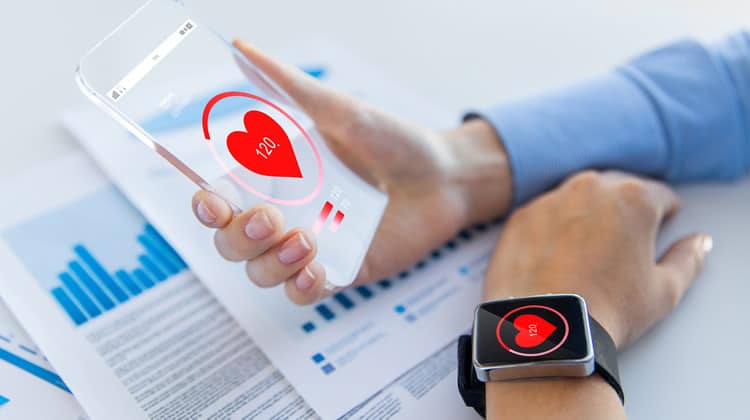Have you ever thought the leather watch which only shows time will innovate in a way in the future that it can also tell you about your health? No of course not, because the future has always been unpredictable and perhaps because technology moves out of our hand wrist to our shirt sleeve. Wearables have long been hailed as the smart technology’s potential. The old clunky bracelet and headset industry isn’t gradually getting focused on clever textiles. You simply wear Smart clothes and smart wearable.
Companies watch people’s internet activity in a variety of ways. They use a variety of data points to analyze consumers to include personalized services, ranging from social media messages to online orders. Wearable gadgets, such as smartwatches and fitness trackers, are the next step of these data-gathering initiatives. These devices can communicate with one another and monitor the person’s heart rate, blood pressure, sleep cycles, and measures taken. However, the technology’s promise is far greater. Engineers are now inserting cameras, circuitry, and other wearable components into textile, resulting in a modern breed of wearables known as smart clothing. Isn’t it interesting to wear clothes that will track your health and always remind you to take care of yourself?

According to Grand View Research, the global smart fabrics industry was worth $878.9 million in 2018 and is projected to hit $5.55 billion by 2025, with North America holding the biggest share. Clearly, this latest generation of technology can transform the fashion industry in the coming years, and recent advances in the area suggest the future is sooner than we expect.
According to John T. Chambers, “Wearable technology will tell us how well we are sleeping and whether we need to exercise. Sensors in the street will help us avoid traffic jams and find parking. Telemedicine applications will allow physicians to treat patients who are hundreds of miles away”.
Know what happened when fashion meets Technology
If you are a fitness freak as well as love to walk with fashion then these smart wearables are for you. These Wearables will make you the center of attraction in a crowded place. Intelligent tops, trousers, and coats may help people avoid heart disease, treat diabetes, calm their bodies, and increase their overall quality of life, in addition to looking healthy. Smart apparel has expanded into a market worth $5.3 billion by 2024 as a result of these advantages. And, in what appears to be the inevitable progression of the apparel industry, companies are constantly offering consumers creative solutions. Sensor-embedded clothing is thus just the first step toward transforming smart textile into a valuable data-gathering asset for a variety of applications.

Blumio, a Silicon Valley company, is on the verge of achieving the Holy Grail of blood pressure control technology: a wearable tracker that can deliver constant readings. Compared to tonometer-based techniques that are more complex to use and implement, using a contact-less, pressure-free monitor can provide precise blood pressure readings. In an interview with Fierce Electronics, the CEO Catherine Liao said that Our team is working on developing a new form of the radar sensor. Although there are FDA-approved tonometer-based blood pressure sensors, they are difficult to use since they require accurate positioning and continuous pressure applied to the measuring point, which can cause pain and bruising. Our sensor can generate a pressure signal that is comparable to that of a tonometer, as we demonstrated in our IEEE article. This gives us strong confidence that we can achieve precise BP readings that are comparable to tonometer-based methods while retaining all of the cuffless wearable benefits.
Sportswear with wearable technologies is becoming increasingly fashionable, and it’s worth mentioning…
Are you worried after putting on any party or get-together because of the covid virus? Stop worrying and look at what MIT has developed to finish all the fear of Covid-19. The Massachusetts Institute of Technology (MIT) recently developed a COVID-19 sensor that can be conveniently integrated into the wearer’s clothing. The signs and symptoms of the body, such as breathing rate, pulse rate, and body temperature, can all be monitored with these waterproof sensors. Furthermore, these are so thin, aiding in the preservation of the garment’s aesthetics. This isn’t just about keeping track of one’s blood pressure and cardiovascular condition. The very same device is used to create clothing that can change colors on demand, which is why such garments are quickly gaining popularity with both young and old people. Furthermore, many garments have developed piezoelectric cells that enable users to charge their smartphones at any time.

With the assistance of electronics and specialized clothes, technical advances in every aspect of our lives, including athletics, have helped overcome some of the issues. In fact,’ smart apparels’ is a novel approach to tracking athletes’ health and fitness levels. Remote tracking is one of the most significant advantages of using smart wearables in sportswear. Sportsmen and women who are often engaged in exercise exercises and activities do not need the physical intervention of a qualified professional to assess their health status. As a result, his or her health status can be tracked from wherever and at any time. Furthermore, smart apparels assist in detecting organ system violations and determining the causes that influence sporting outcomes – a vital prerequisite in today’s times where rivalry is at its peak in sports.
Smart clothes and smart wearable are a novel means of diagnosing functional disabilities in athletes promptly, while stationary periodic tests are not quite as descriptive, precise, or simple. Furthermore, screening-evaluation of any human body functional state is possible, especially during stressful times, and it is also convenient. Smart apparels are seldom physically distinguishable from regular clothing, and athletes are hardly bothered by them. So, when smart sportswear allows an athlete or a sports team to practice at full speed, who wouldn’t want to wear it? Shoes with built-in trackers are becoming increasingly common among athletes, much like sportswear. Smart wearables in athletic wear receive appropriate biometric information separately and then transmit it to an external recipient, such as the Internet or Web computers and phones, thanks to the use of an intelligent cloth with embedded and printed sensors that are enhancing our healthcare in the most convenient and hassle freeway.
Final note:
Harsha Rao has bigger ambitions to get involved with projects related to smart wearables and learn about emerging trends with the aid of industry experts. He thinks that as a cohesive unit, we will accomplish and get success a lot in our field. above you will know about Smart clothes and smart wearable.
